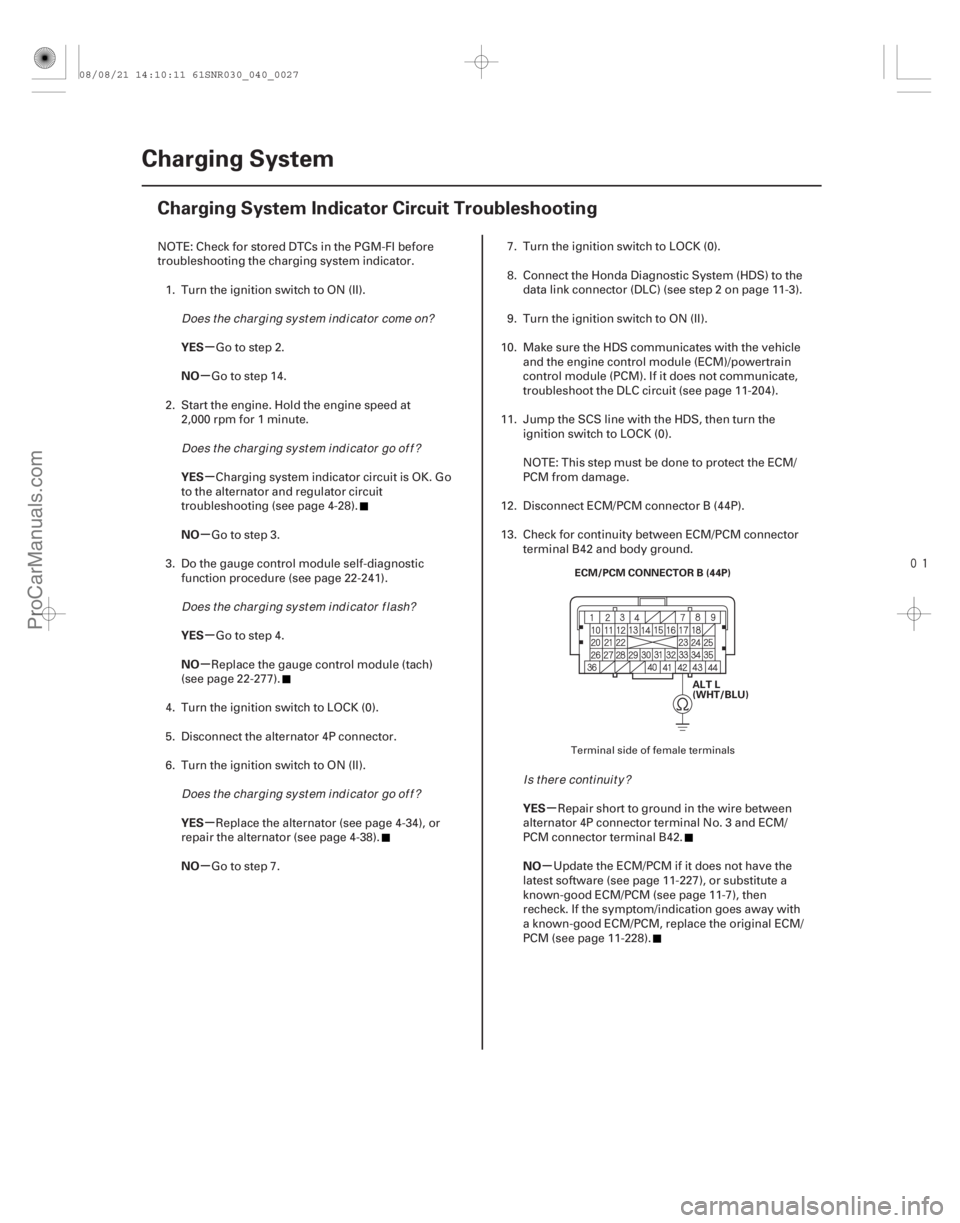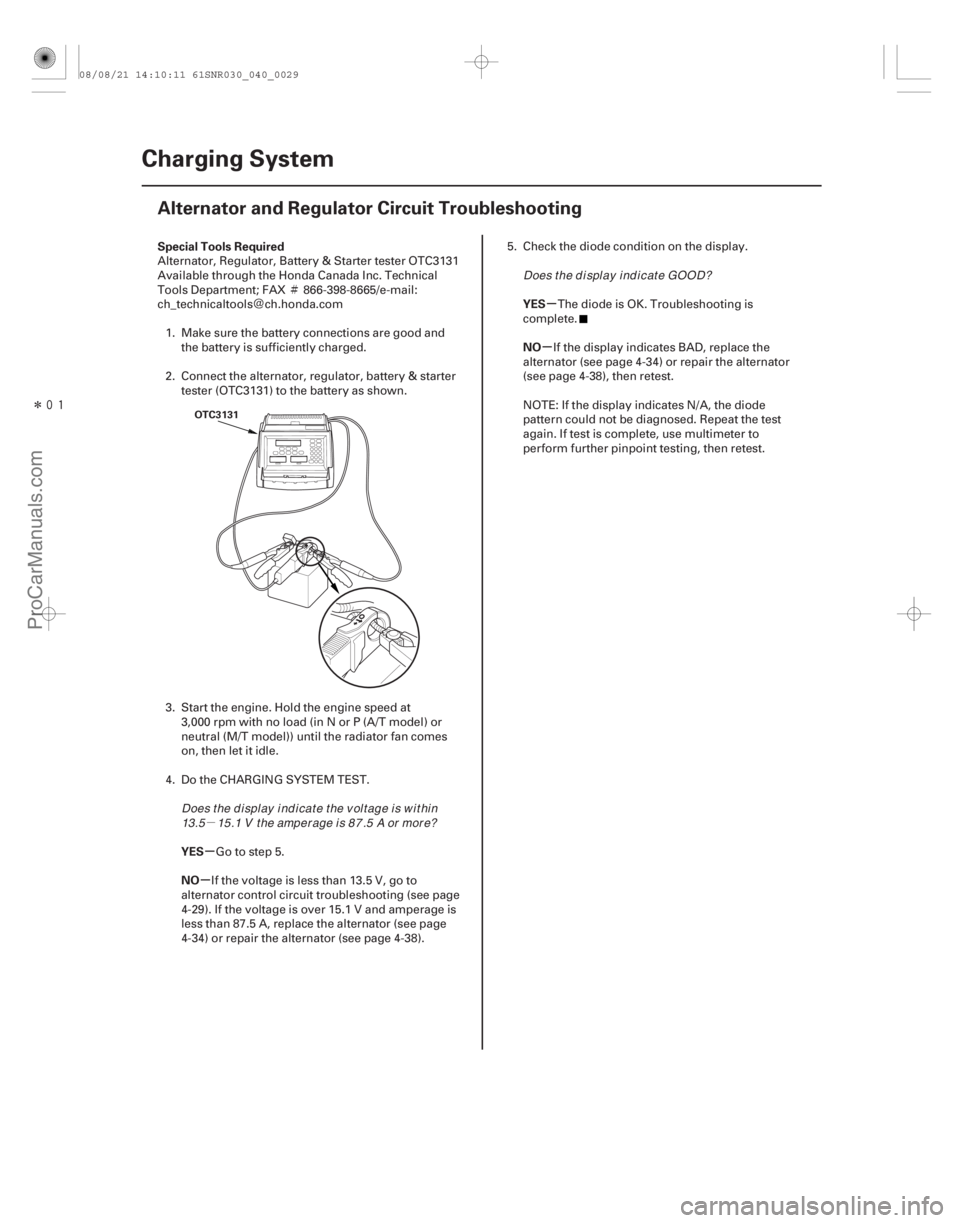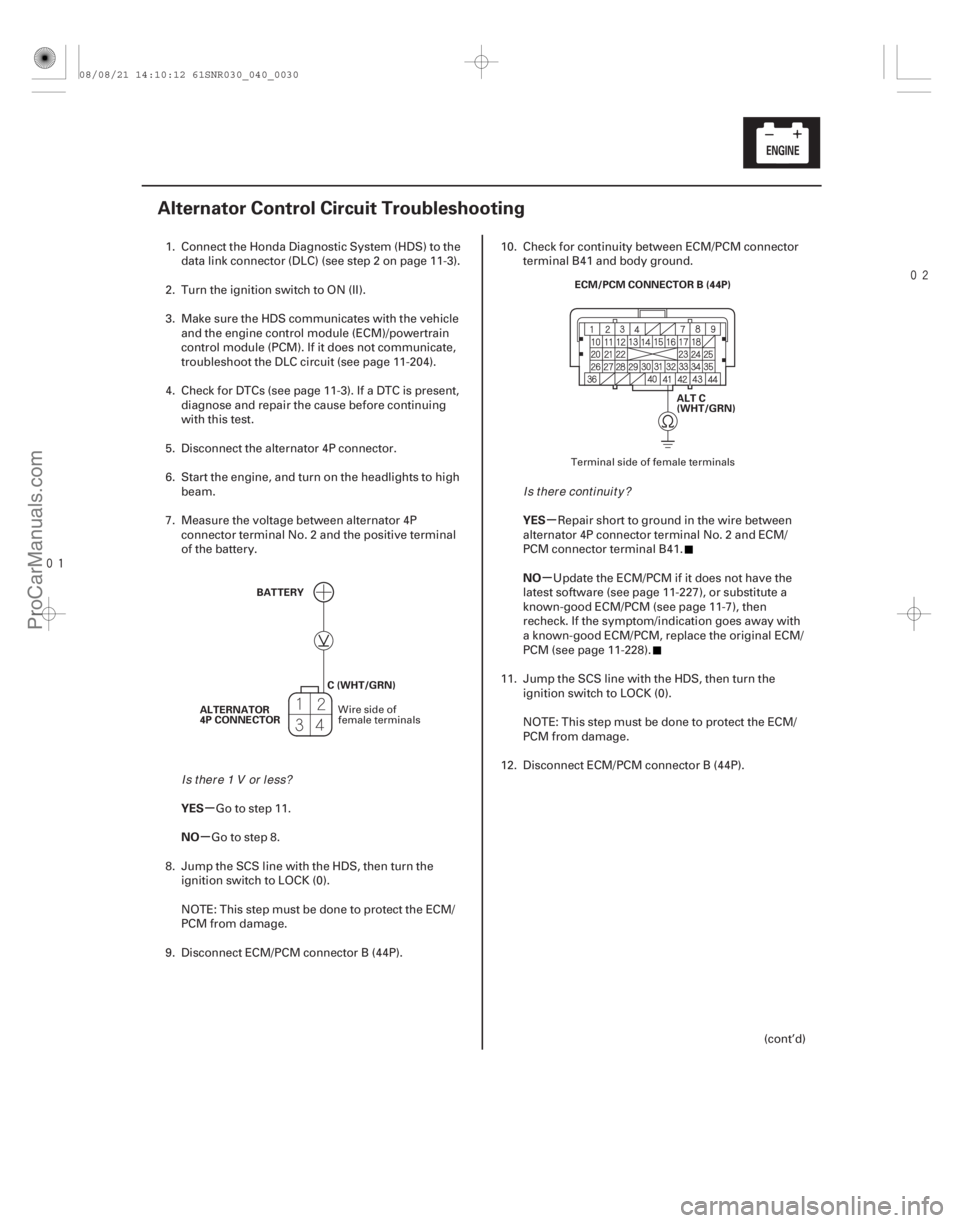Page 58 of 2893
���
����
���
�(�#�'�������������������������������
� �����)����
Removal
K20Z2 engine
K20Z3 engine
4-10 Starting System
Starter Removal and Installation
1. Do the battery terminal disconnection procedure
(see page 22-68).
2. Remove the splash shield. 3. Remove the intake manifold bracket.
08/08/21 14:09:24 61SNR030_040_0011
ProCarManuals.com
DYNOMITE -2009-
Page 59 of 2893
����
���� �����
�����
Installation
4-11
A
B
A
BC B
CA 8x1.25mm
9 N·m (0.9 kgf·m, 7 lbf·ft)
10x1.25mm
44 N·m
(4.5 kgf·m, 33 lbf·ft) 10x1.25mm
64 N·m
(6.5 kgf·m, 47 lbf·ft)
A
4. Remove the harness clamp (A), then the two bolts(B) securing the starter, then remove the starter
from the engine.
5. Disconnect the positive starter cable (A) and the S terminal connector (B).
6. Remove the harness clamp (C), then remove the starter. 1. Install the harness clamp (A).
2. Connect the positive starter cable (B) and S
terminal connector (C). Make sure the starter cable
crimped side of the ring terminal faces away from
the starter when you connect it.
3. Install the starter, and tighten the two bolts, then install the harness clamp (A).
(cont’d)
08/08/21 14:09:25 61SNR030_040_0012
ProCarManuals.com
DYNOMITE -2009-
Page 60 of 2893
����
��������
K20Z2 engine
K20Z3 engine
4-12 Starting System
Starter Removal and Installation (cont’d)
8x1.25mm
22 N·m
(2.2 kgf·m, 16 lbf·ft)
8x1.25mm
22 N·m
(2.2 kgf·m, 16 lbf·ft)
4. Install the intake manifold bracket. 5. Install the splash shield.
6. Do the battery terminal reconnection procedure (see page 22-68).
7. Start the engine to make sure the starter works properly.
08/08/21 14:09:25 61SNR030_040_0013
ProCarManuals.com
DYNOMITE -2009-
Page 68 of 2893

���
����
�(�#�'���������������
�����������������"�����)���� �¶
�¶
Ignition Timing
M/T model: 8 ° 2 ° BTDC (RED mark (B)) at
idle in neutral
A/T model: 8 ° 2 ° BTDC (RED mark (B)) at idle in N or P
4-20Ignition System
Ignition Timing Inspection
A
B
1. Connect the Honda Diagnostic System (HDS) to the data link connector (DLC) (see step 2 on page 11-3).
2. Turn the ignition switch to ON (II).
3. Make sure the HDS communicates with the vehicle and the engine control module (ECM)/powertrain
control module (PCM). If it does not communicate,
troubleshoot the DLC circuit (see page 11- 204).
4. Check for DTCs (see page 11-3). If a DTC is present, diagnose and repair the cause before continuing
with this test.
5. Start the engine. Hold the engine speed at 3,000 rpm with no load (in N or P (A/T model) or
neutral (M/T model)) until the radiator fan comes
on, then let it idle.
6. Check the idle speed (see page 11-309).
7. Jump the SCS line with the HDS.
8. Connect the timing light to the service loop (white tape). 9. Aim the light toward the pointer (A) on the cam
chain case. Check the ignition timing under a no
load condition (headlights, blower fan, rear window
defogger, and air conditioner are turned off).
10. If the ignition timing differs from the specification, check the cam timing. If the cam timing is OK,
update the ECM/PCM if it does not have the latest
software (see page 11-227), or substitute a known-
good ECM/PCM (see page 11-7), then recheck. If the
system work properly, and the ECM/PCM was
substituted, replace the original ECM/PCM
(see page 11-228).
11. Disconnect the HDS and the timing light.
08/08/21 14:10:07 61SNR030_040_0021
ProCarManuals.com
DYNOMITE -2009-
Page 70 of 2893
�����µ�µ
Spark Plugs
K20Z2 engine
DENSO: SKJ20DR-M11
K20Z3 engine
DENSO: SK22PR-M11S
Electrode Gap
Standard(New): 1.0 1.1 mm (0.039 0.043 in.)
4-22 Ignition System
Spark Plug Inspection (cont’d)
B
A
3. Replace the plug at the specified interval or if the
center electrode (A) is rounded, or if the spark plug
gap (B) is out of specification. Use only the listed
spark plugs.
NOTE: Do not adjust the gap of iridium tip plugs.
4. Apply a small amount of anti-seize compound to the plug threads, and screw the plugs into the
cylinder head, finger-tight. Torque them to 18 N·m
(1.8 kgf·m, 13 lbf·ft).
08/08/21 14:10:07 61SNR030_040_0023
ProCarManuals.com
DYNOMITE -2009-
Page 74 of 2893

���
�(�#�'�����������
���
�������
���������������)����
�µ
�µ
�µ
�µ
�µ
�µ
�µ
�µ �µ
�µ
YES
NO
YES
NO
YES
NO
YES
NO
YES
NO
4-26Charging System
Charging System Indicator Circuit Troubleshooting
ALT L
(WHT/BLU)
ECM/PCM CONNECTOR B (44P)
NOTE: Check for stored DTCs in the PGM-FI before
troubleshooting the charging system indicator.
1. Turn the ignition switch to ON (II).
Go to step 2.
Go to step 14.
2. Start the engine. Hold the engine speed at 2,000 rpm for 1 minute.
Charging system indicator circuit is OK. Go
to the alternator and regulator circuit
troubleshooting (see page 4-28).
Go to step 3.
3. Do the gauge control module self-diagnostic function procedure (see page 22-241).
Go to step 4.
Replace the gauge control module (tach)
(see page 22-277).
4. Turn the ignition switch to LOCK (0).
5. Disconnect the alternator 4P connector.
6. Turn the ignition switch to ON (II).
Replace the alternator (see page 4-34), or
repair the alternator (see page 4-38).
Go to step 7. 7. Turn the ignition switch to LOCK (0).
8. Connect the Honda Diagnostic System (HDS) to the
data link connector (DLC) (see step 2 on page 11-3).
9. Turn the ignition switch to ON (II).
10. Make sure the HDS communicates with the vehicle and the engine control module (ECM)/powertrain
control module (PCM). If it does not communicate,
troubleshoot the DLC circuit (see page 11-204).
11. Jump the SCS line with the HDS, then turn the ignition switch to LOCK (0).
NOTE: This step must be done to protect the ECM/
PCMfromdamage.
12. Disconnect ECM/PCM connector B (44P).
13. Check for continuity between ECM/PCM connector terminal B42 and body ground.
Repair short to ground in the wire between
alternator 4P connector terminal No. 3 and ECM/
PCM connector terminal B42.
Update the ECM/PCM if it does not have the
latest software (see page 11-227), or substitute a
known-good ECM/PCM (see page 11-7), then
recheck. If the symptom/indication goes away with
a known-good ECM/PCM, replace the original ECM/
PCM (see page 11-228).
Terminal side of female terminals
Does t he char gi ng sy st em i nd i cat or come on?
Does t he char gi ng sy st em i nd i cat or go of f ?
Does t he char gi ng sy st em i nd i cat or f l ash?
Does t he char gi ng sy st em i nd i cat or go of f ? Is there continuity?
08/08/21 14:10:11 61SNR030_040_0027
ProCarManuals.com
DYNOMITE -2009-
Page 76 of 2893

�µ�Ì
�Ï
����
�(�#�'�����������
���
�������
���������������)����
�µ
�µ �µ
�µ
Special Tools Required
YES
NO YES
NO
4-28
Charging System
Alternator and Regulator Circuit Troubleshooting
OTC3131
Alternator, Regulator, Battery & Starter tester OTC3131
Available through the Honda Canada Inc. Technical
Tools Department; FAX
866-398-8665/e-mail:
ch_technicaltools ch.honda.com
1. Make sure the battery connections are good and the battery is sufficiently charged.
2. Connect the alternator, regulator, battery & starter tester (OTC3131) to the battery as shown.
3. Start the engine. Hold the engine speed at 3,000 rpm with no load (in N or P (A/T model) or
neutral (M/T model)) until the radiator fan comes
on, then let it idle.
4. Do the CHARGING SYSTEM TEST.
Go to step 5.
If the voltage is less than 13.5 V, go to
alternator control circuit troubleshooting (see page
4-29). If the voltage is over 15.1 V and amperage is
less than 87.5 A, replace the alternator (see page
4-34) or repair the alternator (see page 4-38). 5. Check the diode condition on the display.
The diode is OK. Troubleshooting is
complete.
If the display indicates BAD, replace the
alternator (see page 4-34) or repair the alternator
(see page 4-38), then retest.
NOTE: If the display indicates N/A, the diode
pattern could not be diagnosed. Repeat the test
again. If test is complete, use multimeter to
perform further pinpoint testing, then retest.
Does the display indicate the voltage is within 13.5 15 .1 V t he amper age i s 87 .5 A or mor e? Does t he d i spl ay i nd i cat e GOOD?
08/08/21 14:10:11 61SNR030_040_0029
ProCarManuals.com
DYNOMITE -2009-
Page 77 of 2893

���
����
�(�#�'�����������
���
�������
���������������)����
�µ
�µ �µ
�µ
YES
NO YES
NO
4-29
Alternator Control Circuit Troubleshooting
BATTERY
ALTERNATOR
4P CONNECTOR C (WHT/GRN) ALT C
(WHT/GRN)
ECM/PCM CONNECTOR B (44P)
1. Connect the Honda Diagnostic System (HDS) to the
data link connector (DLC) (see step 2 on page 11-3).
2. Turn the ignition switch to ON (II).
3. Make sure the HDS communicates with the vehicle and the engine control module (ECM)/powertrain
control module (PCM). If it does not communicate,
troubleshoot the DLC circuit (see page 11- 204).
4. Check for DTCs (see page 11-3). If a DTC is present, diagnose and repair the cause before continuing
with this test.
5. Disconnect the alternator 4P connector.
6. Start the engine, and turn on the headlights to high beam.
7. Measure the voltage between alternator 4P connector terminal No. 2 and the positive terminal
of the battery.
Go to step 11.
Go to step 8.
8. Jump the SCS line with the HDS, then turn the ignition switch to LOCK (0).
NOTE: This step must be done to protect the ECM/
PCM from damage.
9. Disconnect ECM/PCM connector B (44P). 10. Check for continuity between ECM/PCM connector
terminal B41 and body ground.
Repair short to ground in the wire between
alternator 4P connector terminal No. 2 and ECM/
PCM connector terminal B41.
Update the ECM/PCM if it does not have the
latest software (see page 11-227), or substitute a
known-good ECM/PCM (see page 11-7), then
recheck. If the symptom/indication goes away with
a known-good ECM/PCM, replace the original ECM/
PCM (see page 11-228).
11. Jump the SCS line with the HDS, then turn the ignition switch to LOCK (0).
NOTE: This step must be done to protect the ECM/
PCMfromdamage.
12. Disconnect ECM/PCM connector B (44P).
(cont’d)
Wire side of
female terminals Terminal side of female terminals
Is t her e 1 V or l ess?
Is there continuity?
08/08/21 14:10:12 61SNR030_040_0030
ProCarManuals.com
DYNOMITE -2009-